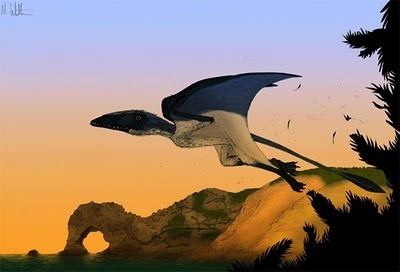Order Pterosauria? Rank Species | Class Sauropsida Phylum Chordata | |
 | ||
Genus FaxinalipterusBonaparte et al., 2010 People also search for Cargninia, Minicynodon, Soturnia | ||
Faxinalipterus is a genus of vertebrate, possibly a pterosaur, from the Late Triassic Caturrita Formation of southern Brazil.
The type species, Faxinalipterus minima was named and described in 2010 by José Fernando Bonaparte, Marina Bento Soares and César Leandro Schultz. The generic name is derived from Faxinal do Soturno and a Latinised Greek pteron, "wing". The specific name, from Latin minimus, means "smallest".
Fossils of the species were found in 2002 and 2005 at a site 1.5 kilometres northeast of Faxinal do Soturno, Rio Grande do Sul, from the Caturrita Formation dating from the Carnian-Norian, 220–215 million years old. The holotype, UFRGS PV0927T, is part of the collection of the Universidade Federal do Rio Grande do Sul and consists of several, partially fragmentary, limb elements, perhaps of a single individual. These do not include bones from the hand. An upper jaw fragment, a left maxilla with three teeth, has been referred to the species.
Faxinalipterus is a rather small animal, with an estimated total humerus length of eighteen millimetres. The size has been compared to that of a sparrow. The hind limbs, much better conserved than the front limbs, are relatively long. From the maxilla it can be inferred that the skull is deep and lightly built with large openings. The maxillary teeth, probably numbering eighteen, are elongated and recurved.
The describers have assigned Faxinalipterus to the Pterosauria, based on its long hollow limbs and saddle-shaped upper joint of the relatively short and robust humerus, suitable to perform a wing stroke. They see it as perhaps the oldest pterosaur known, as it possibly predates European finds from the Norian. That the possible age difference cannot be large, they see as an indication of rapid evolution in early pterosaurs. Because the Caturrita Formation consists of terrestrial sandstones, that evolution would have had its origins in a terrestrial, not coastal, habitat. They also concluded Faxinalipterus is the most basal known pterosaur, basal features including a lack of fusion between tibia and fibula, a thin radius and a coracoid that has not fused to the scapula. However, Alexander Kellner has suggested Faxinalipterus might be not be a pterosaur but a basal member of the Pterosauromorpha instead or, if the lack of fusion between tibia and fibula is plesiomorphic, even a sister taxon of the Ornithodira. Fabio Marco Dalla Vecchia (2013) stated that he was "unable to find any unequivocal pterosaur features" in the known fossils of F. minima; in fact, according to the author, "the purported humerus is quite unlike the humeri of the Triassic pterosaurs". Dalla Vecchia did not consider Faxinalipterus to be a pterosaur, but did not state what group of vertebrates it belonged to.
